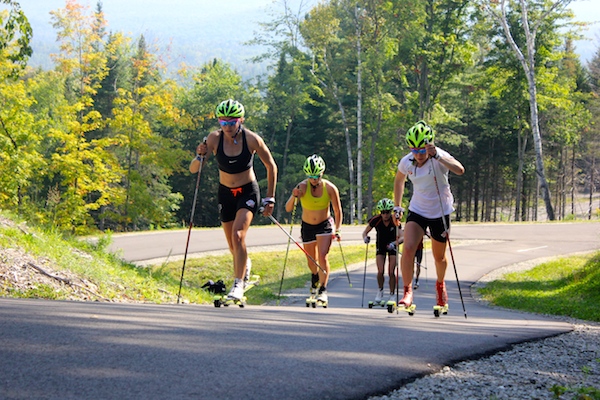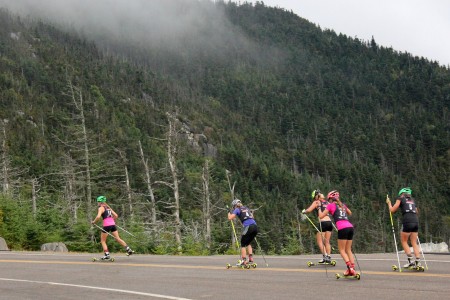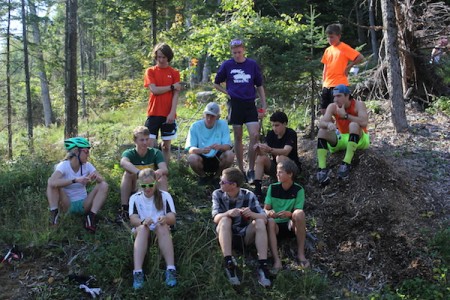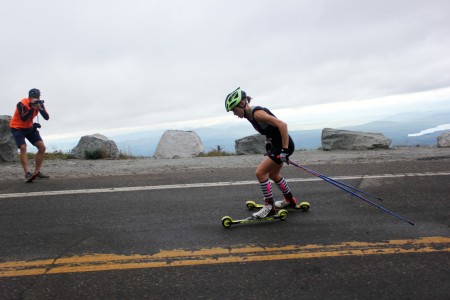
LAKE PLACID, N.Y. – There’s no doubt that the U.S. Ski Team (USST) has grown in results and popularity in recent years. While the team has been advancing the stars and stripes abroad, the sport has gained traction on the home front.
While no single factor can claim credit to the humble rise of nordic skiing in America, some often-unseen pieces of the puzzle are the USST camps held throughout the offseason.
As the first week of September came to a close, the USST concluded its annual training camp in Lake Placid, N.Y. The camp, which started Aug. 25, had a large emphasis on intensity and included a classic-rollerski sprint simulation, various speed workouts, and the challenging Climb to the Castle rollerski race up nearby Whiteface Mountain.
While many western skiers were missing from the lineup, USST athletes Jessie Diggins, Ida Sargent, Liz Stephen, Sophie Caldwell, Ben Saxton, Paddy Caldwell, Andy Newell, and Simi Hamilton were in attendance for the majority of the camp.
For Paddy Caldwell, this was the first time that the Dartmouth sophomore had trained with a near-full team since he was named to the USST this spring.
“It’s nice to have a focused group together and a cohesive connection,” Caldwell said. “In particular this camp has been nice to get to know the guys.”

Caldwell, who took classes and trained at Dartmouth for most of the summer, was injured in late July with a torn disk or muscle in his mid-to-lower back. The 20 year old said that while he wasn’t doing any high-impact activities such as intervals, he felt that the camp was helping him get back into his normal training routine.
He predicted he would be fully recovered by the time the USST travelled to Park City, Utah, for its fall altitude camp in October.
In addition to the USST, a trove of athletes from the Stratton Mountain School (SMS), Craftsbury Green Racing Project (CGRP), Sun Valley Ski Education Foundation (SVSEF), and various other clubs across the country made the trip for the two-week event.
One such athlete was Caitlin Gregg of Team Gregg who, after claiming the overall SuperTour title last March, is gearing up to start on the World Cup this fall.
“The level of training has been really high for every session,” Gregg said. “The weather’s been awesome which has been a super plus here in the East. It can get kind of rainy but we’ve had some sunny days.”

The Lake Placid camp created a daily routine for its participants. Before each session skiers would gather to watch World Cup footage to stimulate the athletes’ minds before hitting the pavement. In many cases, they would watch Norway’s Marit Bjørgen double pole or Petter Northug start.
Once a rollerski workout was over, athletes received video clips of themselves from the workout to allow for reflection and thoughts on future improvement.
While technique advice from the coaching staff was a key part of the camp, the goal was to create an environment where athletes could conquer their technique difficulties on their own.
“Some camps we spend a lot of time talking about technique, but I think it’s really important to build the infrastructure and let them figure it out on their own at some camps,” U.S. Ski Team Women’s Coach Matt Whitcomb said. “We provide them the tools to figure out their technique projects. “
Many times that means relying on fellow athletes for technique improvements.
It’s something that Whitcomb has seen advance in recent years and he believes it’s a positive development for his athletes and the sport.
“Different people recognize each other’s strengths and they know that they themselves are used as a demonstration,” he said. “Everyone has their strengths that they are expected to share.”
Whitcomb likes to remove himself as the source of all coaching, and believes that a healthy level of self-coaching can often lead to greater development.

“When too much coaching happens – and that can be too much technique coaching or too much psychological coaching – the athletes learns to really depend on the coach and it becomes a crutch. They stop learning on their own,“ he said.
While the camp was focused on intensity, it also provided a means to improve tactical skiing in a group setting.
According to Whitcomb, it’s often easy for athletes to focus on building capacity, speed and a strong mindset, which are all incredibly important. However, in focusing on the big-picture improvements, athletes can miss what Whitcomb calls the “low-hanging fruit.”
With skiers like Kikkan Randall, Hamilton and Newell — considered some of the best technical skiers in the world — Whitcomb believes the U.S. has the unique opportunity to increase its technical ability.
“They are assets on our team that we can use in workouts to set the bar as well as refining their own skills,” he said. “Learning to ski these transitions doesn’t take more energy. It actually takes less energy to take a better line. We’re trying to move away from having the fastest hill climbers and the most powerful skiers to the most well-rounded skiers.”
When asked how the USST coaches balance the addition of other elite team athletes in the camp, Whitcomb said that it’s been something the team as been working on for several years.
In past camps, Whitcomb said that there were too many participants and many of the workouts would lose their value.
“We’ve always been about the partnerships and we’ve known that that’s the way to take a fractured ski culture in the U.S. and bring it together,” he said. “But what has snuck away from us at a camp here and there was that we were almost being too open. The most competitive workouts in the nation were too open and thus the target was too big.”
Whitcomb said this year’s Lake Placid camp had a stable balance where the national team and additional elite skiers were able to create an environment where everyone was able to bring something to the table.
Now that the sea-level camp is over, athletes will travel back to their respective clubs and partake in a much-needed rest period. As the intensity from the late summer begins to set in, they will continue to build volume until the USST gathers again in Park City, Utah, on Oct. 4. There, they will participate in a three-week altitude camp that takes them from the U.S. Ski & Snowboard Association’s Center of Excellence (COE) to Frozen Thunder in Canmore, Alberta.
FasterSkier’s On-Site Coverage of the 2014 USST Lake Placid Training Camp
Lander Karath
Lander Karath is FasterSkier's Associate Editor from Bozeman, Montana and a Bridger Ski Foundation alumnus. Between his studies at Middlebury College in Vermont, he is an outdoor enthusiast and a political junkie.



